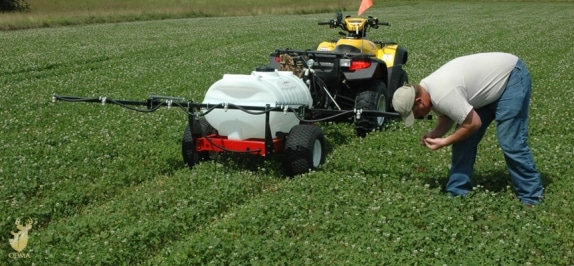So, you have learned to identify your major weed problems. You have done your homework and identified the herbicide necessary to control the weeds in your food plots. You have planned ahead, and you are spraying at the correct time. However, none of this matters if you haven’t calibrated your sprayer!
Herbicide application must be precise. Many herbicides are applied in ounces per acre. It is absolutely critical to calibrate your sprayer and know exactly how many gallons of solution you are applying per acre. Once you know how many gallons per acre you are applying, then you simply add the amount of herbicide recommended to the spray mixture. Calibration is relatively easy and should be done every time herbicides are applied because changes in driving speed, nozzle size and spraying pressure will change application rates. Calibrating your sprayer can be done with a few methods. Here is one method taken from the pages of NDA’s book, Quality Food Plots, and it works for both backpack sprayers and ATV- or tractor-mounted sprayers.
1. Select a driving (or walking) speed that you can easily maintain across the area to be sprayed.
2. Select a spraying pressure – this is usually based on the spray nozzle type used for application. Spraying pressures of 20 to 40 pounds per square inch (psi) are ideal for herbicide application. If the sprayer produces a fine mist of tiny droplets that drift easily, the pressure is too high. Most backpack sprayers are capable of generating pressures of 20 to 40 PSI, and power sprayers can be adjusted easily within this pressure range.
3. Select a nozzle type and size. A 0.2 or 0.3 gallon-per-minute nozzle is usually needed to apply 20 gallons per acre at speeds around 4 mph and spray pressures of about 30 psi. Fan-type nozzles work best for herbicide application. A TeeJet XR8002 or XR8003 is a good nozzle for herbicide application. These nozzles are usually spaced 20 inches apart on a sprayer boom to achieve good broadcast coverage. Backpack sprayers with one nozzle usually spray an effective width of about 20 inches; they are more efficient if a 4 1/2-foot boom with four nozzles is attached.
Note: Sprayer tip descriptions (such as “XR8002”) start with an alphabetic abbreviation, followed by the angle of the spray jet, and the amount of spray output per minute at a given pressure. In XR8002, “80” is the angle of the spray leaving the tip, and “02” is tenths of gallons per minute (gpm) of spray at 40 PSI. So, XR11001 has a 110-degree spray and a 0.1 gpm nozzle.
4. Set up your “calibration course.” To select the length of the calibration course, divide 340 by the nozzle spacing in feet. A 20-inch nozzle spacing is 1.67 feet, so 340 divided by 1.67 equals 204 feet. This is the length of the calibration course for 20-inch nozzle spacing.
5. Time how long it takes you to walk (for a backpack sprayer) or drive the length of the calibration course. At 4 mph, it will take about 36 seconds to travel 204 feet. Precise travel speed is important.
6. Catch the spray from one nozzle for the same length of time it takes to travel the calibration course, and measure the amount of spray liquid you collect. The number of ounces is equal to the application rate in gallons per acre.
For example: If you collect 22 ounces from a nozzle, the application rate of spray material is 22 gallons per acre. If the calibration rate is more than 25 percent off from the desired rate, change nozzle size to achieve the desired rate. You can increase or decrease travel speed, but this will either slow down your job or result in speeds that can become unsafe or impractical.
Don’t fool yourself; this is not something that can be guessed. Calibrate your sprayer!
About the Author: Dr. Craig Harper is a professor of wildlife management and the Extension Wildlife Specialist at the University of Tennessee. Craig conducts research and extension programming on several issues related to Quality Deer Management. He is a Life Member of the NDA and a frequent contributor to Quality Whiteails magazine.
